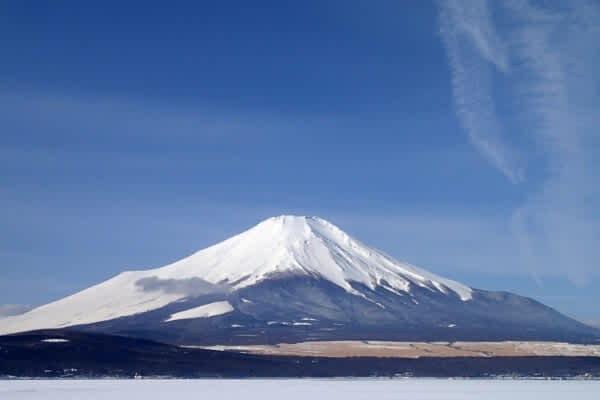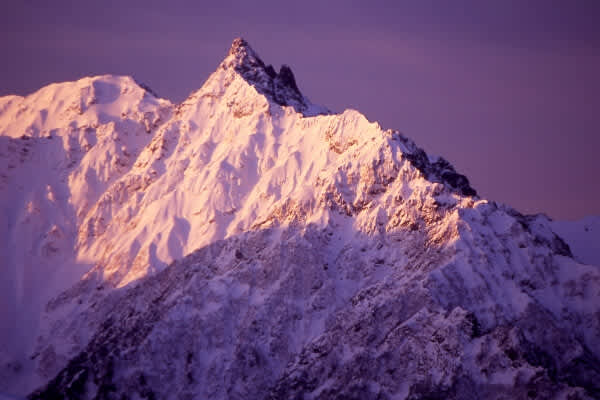Discover Japan’s incredible mountainscapes with alpinist Hiroshi Hagiwara
The majestic mountain ranges and beautiful forests of Japan make it an ideal destination for everyone, from nature enthusiasts to avid alpinists. Renowned Japanese mountaineer Hiroshi Hagiwara talks about what makes the landscapes in Japan so unique and introduces some of his favorite scenic spots.
-
Hiroshi Hagiwara
Mountaineer and Director of Yama-Kei Publishers Co., Ltd.
Tenacious Japanese mountaineer Hiroshi Hagiwara was a part of the team that first conquered Outlier (Janak Chuli) East, a 7,035-meter Himayalan peak. He has served as editor-in-chief of a leading mountain magazine and a jury member for the prestigious Piolets d'Or mountaineering awards.
Your team was the first to conquer Outlier East. Tell us about your expedition.
The 7,035-meter Outlier (Janak Chuli) East was an unconquered peak located on the Nepal-China border. The first time we attempted to scale it, the condition of the snow was not very good, so we had to retreat. Our second attempt was two years later.
After a tough vertical climb, we finally reached the top. I was filled with a sense of achievement and gratitude to everyone involved. Since we were the first to scale this mountain, we were rewarded with a view that was never witnessed before by human eyes. We could see Mt. Everest looming in the distance, and the mountains on the Chinese side of the Himalayas. What stood out for me was the distinct lack of color—everything was covered in shades of white and brown. It’s quite a contrast from the lush, verdant mountains of Japan. This climb inspired me to further explore the beautiful nature in my own home country.

Hagiwara on the summit of Outlier (Janak Chuli) East
What makes Japan’s mountains unique for you?
Throughout my mountaineering career, I’ve explored the European Alps, as well as mountains in Norway, Morocco, and North America. Japan is a small island country, so I think the landscapes here can’t compete with these places in terms of scale. But I think the rich variety of vegetation and the pristine quality of the water is what makes the natural environment here so special. The country stretches from north to south, so there’s great climatic variation in each region due to the difference in latitude. This is why there’s so much biodiversity. For example, you can see alpine plants even at low altitudes on the northern island of Hokkaido, while the southernmost archipelago of Okinawa teems with tropical vegetation.
Not only that, the landscapes transform with the changing of the seasons. I enjoy exploring these places throughout the year. You can see brilliant fresh green leaves and wild cherry blossoms in spring and in fall, the forests are colored in beautiful hues of gold and vermillion.

Mt. Nasu in autumn
Some parts of Japan receive an astounding amount of snowfall in the winter, that is why there is an abundance of fresh water throughout the country’s woodlands. I often encounter water bodies that are so crystal-clear, you can see shoals of fish swimming around.
All this water makes Japan a paradise for adventure, where you can try all kinds of things from rafting to canyoneering. One unique activity I recommend is sawanobori, which entails scaling crystalline streams to reach a mountaintop. I believe that this is only possible in Japan, since most places in the world tend to have deep gorges which are virtually impossible to climb. If you’re looking for a more relaxing outdoor activity, visit a waterfall or go fishing.

Sawanobori (stream climbing)
Mt. Fuji is Japan’s tallest and most symbolic peak. What’s the best way to experience it?
There’s an old saying in Japan which goes “If you don’t climb Mt. Fuji at least once, you’re a fool. But if you climb it more than once, you’re also a fool.” I don’t necessarily agree with that sentiment as I’ve climbed it multiple times (laughs). I do recommend going there at least once. Ordinary climbers can only access the mountain in summer, from July to mid-September, and I think the best time to climb it is during the sacred ritual that marks the opening of Mt. Fuji (3,776 m). Climbers begin their ascent to the summit at midnight, dressed in religious garb and carrying conch shell horns. It is quite a sight to see. Scaling it at night means that you also get to see the sunrise from the summit. If you’re lucky, you might even see the shadow of the mountain cast over a sea of clouds once the sun is up.
You don’t necessarily have to climb Mt. Fuji to experience its beauty. Since it’s accessible only during the summer, you can opt instead to observe it from the peak of another mountain if you’re visiting off-season. Peaks of the Northern, Central, and Southern Japanese Alps all offer stunning views of the country’s highest peak. For somewhere closer to Tokyo, visitors can try climbing the 599-meter Mt. Takao. Spring is a great time to go, when cherry blossoms and violets are in full bloom. Expect to be treated to views of a snow-capped Mt. Fuji.

Mt. Fuji
Japan has a number of World Heritage Sites. What are some of the best places to visit to experience nature and culture?
The relationship between the Japanese people and mountains goes back a long way. Mountains have been worshiped since over a millennium ago and religious relics from ancient times can still be found in natural landscapes here. There are many places where you can sense history and spirituality.
For example, Mt. Omine has a long spiritual history—it is still frequented by pilgrims and mountain ascetics attired in traditional garments. I found it fascinating that here, you’re greeted by passing hikers with a phrase that translates to “Salutations on your pilgrimage,” rather than the usual “Hello.”
Travelers can also trace the long trail from Mt. Yoshino to Mt. Koya, dotted with ancient statues and other relics. Japan also has a number of sacred mountains—Mt. Fuji, Mt. Hakusan, Mt. Ontake, and Mt. Tateyama have all long been revered by worshippers. Any of these are worth visiting for a taste of spiritual history.

Omine mountains
Another great place is the island of Yakushima in the south part of Japan. It is a Natural World Heritage site known for its ancient cryptomeria trees and mossy landscape. Many visitors undertake long treks to see the oldest tree on the island, the Jomon Sugi tree, believed to be thousands of years old.
In the north is the primeval beech forest of Shirakami Sanchi. The place is particularly stunning in autumn, when the beech leaves change color. If you go even further north to Hokkaido, you can explore the untouched wilderness of Shiretoko. This lush, mountainous area is home to many creatures such as the elusive Blakiston’s fish owl, the brown bear, and Ezo red fox.

Yakushima
What spots do you recommend for climbing or trekking enthusiasts?
The Northern, Central, and Southern Japanese Alps span across the main island of Japan, boasting many peaks over 3,000 meters. In summer, these mountain ranges are great for long, multi-day traverses. You can aim to venture up to iconic peaks like the spear-shaped Mt. Yarigatake (3,180 m) or Japan’s second-highest peak, Mt. Kita (3,193 m). The presence of mountain huts and designated campgrounds throughout these areas are a blessing for trekkers. What’s great about Japan’s alpine landscapes is that they present a juxtaposition of craggy slopes, rocky ridgelines, and vibrant flower meadows. You will be able to find trails suited to a variety of experience and skill levels. Some alpine peaks, like Mt. Tsurugi (2,999 m), are known for extremely harsh conditions in winter, making them ideal training grounds for those preparing for tough, professional-level expeditions.

Karasawa Cirque in summer

Mt. Yarigatake in winter
What spots do you recommend for more casual hikers and photo enthusiasts?
For casual hikers, the Kirigamine highlands in Nagano can be accessed without a tough climb. You can hop on a ski lift to get to the highest point in the area, Mt. Kuruma (1,925 m). In summer, the gentle slopes bloom with a rich variety of flowers—the clusters of yellow broad dwarf daylilies and Japanese azaleas are incredibly photogenic. Nearby is the Utsukushigahara plains, which offers amazing views of the Northern Japanese Alps. I’ve seen lots of people take jump-shot photos here, to make it look like they’re soaring over Japan’s highest mountains. You can get creative and take all kinds of interesting photos (laughs).
There are plenty of mountains easily accessible by cable car, such as the Daisetsuzan mountain range in Hokkaido, where you’ll be rewarded with spectacular volcanic views and delicate alpine flora. Travelers can access the high-altitude Tateyama mountains in the Northern Alps using several modes of transportation, collectively known as the Tateyama Kurobe Alpine Route. For a casual trek and picture-perfect views, head to the wetlands of Ozegahara.

Ozegahara wetland
Since almost three quarters of Japan’s landscape is forested, it offers a wealth of scenic trails. The sheer variety of outdoor activities and wildlife makes it an excellent destination for visitors looking to immerse themselves in nature.
Recommended article
-
Mt. Fuji Climbing Guide
Mt. Fuji, one of the world's most iconic mountains, is a rewarding climb for experienced and novice hikers alike. Get all the info with this handy guide.
Learn More
-
National Parks of Japan Official Site
There are 34 national parks in Japan located across all regions, from the northern tip of Hokkaido to the southernmost islands of Okinawa. These parks protect Japan's diverse natural environments, including volcanoes, forests, wetlands, coastlines, beaches and coral reefs.
Learn More










